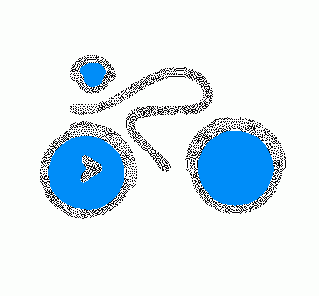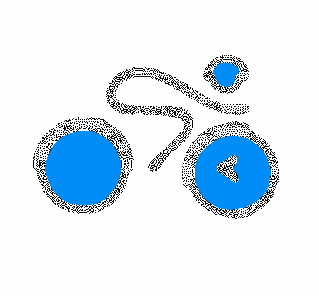| Newsletter - 2011 Archive |
 |
Cycling Club |
 |
| Newsletter - 2011 Archive |
 |
Cycling Club |
 |
Next--->
|
The Evolution of the Cycling Jersey The official 2011 PBP Canada jersey is being offered for sale by the Nova Scotia Randonneurs. I'm not sure what the protocol is for the design and sale of the jersey; it's an attractive-enough design, and I would have bought one, except for that: it doesn't have a full front zipper. It is not up-to-date. I didn't get to have any input about that zipper. And the guys who ordered it don't seem to realize that the jersey has evolved. Again. Jerseys have been constantly evolving over the past 110+ years of cycling, with tank tops and "swimwear" tops visible in photos taken around 1900, to crew necks with buttons along the shoulders among 1930's six-day riders, to buttoned and then zipped polo shirts with collars in the 40's and 50's evolving to the now-prevalent zipped crew necks in the 60's. My first real cycling jersey was a solid blue Italian-made Sergal in 100% wool in a tube knit. The body of the jersey was knitted as a tube, so there were no side seams. This was pretty much the zenith of the Italian wool jersey; it didn't get any better than this. In 1972, when I bought it, most jerseys had five pockets - the standard three in back, plus two in front, intended for very light items such as route sheets or sunglasses. If you put food into them, they would pull and droop. Racers would just cut off the two front pockets (carefully with that seam ripper), since the three in back were all that were really necessary. On the track, you wore a shiny silk jersey with no pockets, which you also wore on hot days on the road or in criteriums and time trials where pockets were not necessary. Aside: I note a modest resurgence of the wool jersey amongst randonneurs, where they are eminently practical. I am just surprised that they don't come with the two extra front pockets, which would be even more practical for this one discipline! Perhaps they are not practical for women; I wouldn't know. In the late 70's, they started making jerseys out of lycra. They didn't require the tremendous care you needed for wool jerseys - you just threw them in the washing machine and then the dryer, or you could hang them up to dry; none of this hand washing in baby shampoo, then pressing out the water with a towel and not letting it dry too fast. The other problem with wool jerseys was that they were not very color-fast. Reds faded particularly quickly. The worst thing would be to do a long climb on a hot day, where you're sweating profusely, in a red wool jersey. By the time you reached the top, it would have turned pink and shrunk two sizes! With lycra, you had a jersey that looked and felt close to silk, but would stretch enough that you could put on a tight racing jersey comfortably (silk doesn't stretch and then snap back very well). Then with computerized photographic sublimation techniques, you could permanently imprint jerseys with any graphics in any color patterns, so you didn't have to bother with embroidery or with ironed-on letters and logos flaking off. Two racing aberrations worth noting occurred in the 80's and later. The first was the "skin-suit", the one piece jersey-shorts combination popular for time trial and track use. The other was the trick aerodynamic jersey, built such that it would influence wind flow and reduce drag. These innovations were not generally applied to jerseys in general and have little application to randonneurs; however, the most recent innovation marks a definite trend, and that is the full front zipper. Zippers had been increasing in length thru the 1990's until finally, around 2000, they would unzip completely. This has two distinct advantages: first, the jersey is much cooler on hot days, especially when climbing, when you can unzip completely and expose the entire trunk to cooling air. Second, you can take off the jesey without having to empty the pockets. (Yeah, you can do this with a regular jersey too, but it's much more awkward and not good for the jersey.) In disciplines such as randonneuring, where you pockets are very likely to be fully-loaded, this can be a time-saver indeed. Plus, if the zipper breaks (zippers seem to be getting much less reliable these days), you can always sew up the bottom of the zipper and revert the jersey to one with just a long zipper. And that is why I will not buy a jersey now that does not have a full zipper. Other considerations to remember about jerseys: they generally come in two styles, racing cut and club cut. Racing cut is meant to be close-fitting for good aerodynamics. Club cut fits a bit looser and is generally more comfortable. You will notice the fabric blows around more in the wind, but then it doesn't make fat guys look like sausages. If I ever see a fat guy in a lycra Molteni jersey, I will just have to laugh. Molteni is an Italian sausage manufacturer that used to sponsor Eddy Merckx. They also make jerseys for women. The sleeves are usually much shorter, and they tend to be more tailored. But in general, jerseys are a unisex item. They often come in numbered Euro-sizes (1 thru 5 or more), but the numbers bear little relation to reality; you just have to try them on. A number means different things to different manufacturers. The jersey should be neither too short (hard to get stuff out of the back pockets, lower back is exposed when in riding position - quite prevalent among women's jerseys) nor too long (you find yourself sitting on the tail of your jersey; see Harold's old wool jersey). Sidebar: How to remove a wool jersey (to minimize wear/strain/damage):
1. Unzip as much as it can go. Sidebar 2: How to put on a full-zip jersey or rain jacket while riding, a good way to save a couple of minutes (Note: do not attempt this with a loaded bike!):
1. On a long, straight section of road with little wind: Hands off bars and sit up straight so you can balance the bike while you ride no-hands.
- March 3, 2011 |